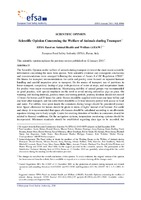Scientific Opinion Concerning the Welfare of Animals during Transport: EFSA Panel on Animal Health and Welfare

Legal Document
Συγγραφέας
European Food Safety Authority
Συλλογικό όργανο
(Other)Ημερομηνία
2011Προβολή/
Θεματικές επικεφαλίδες
Animal protection ; Animal welfare ; Means of transportΠερίληψη
The Scientific Opinion on the welfare of animals during transport reviewed the most recent scientific information concerning the main farm species. New scientific evidence and consequent conclusions and recommendations were arranged following the structure of Annex I of EC Regulation 1/2005 . On fitness for transport, recommendations for cattle and poultry were focused on repeated humane handling and careful inspection prior to transport. On the means of transport, use of partitions in horse transport, compulsory fasting of pigs with provision of water at stops, and temperature limits for poultry were major recommendations. Maintaining stability of animal groups was recommended as good practice, with special emphasis on the need to avoid mixing unfamiliar pigs or goats. On watering and feeding intervals, journey times and resting periods, journey duration should not exceed 12 hours for horses and 29 hours for cattle. Horses should be supplied with water one hour before and one hour after transport, and for cattle there should be a 24 hour recovery period with access to food and water. For rabbits, time spent inside the containers during lairage should be considered journey time. Space allowance for horses should be given in terms of kg/m2 instead of m2/animal. For cattle and sheep, it is recommended that space allowances should be calculated according to an allometric equation relating size to body weight. Limits for stocking densities of broilers in containers should be related to thermal conditions. On the navigation systems, temperature monitoring systems should be incorporated. Minimum standards should be established regarding data type to be recorded, the system and the on-board architecture. Recommendations for further research focused on the thermal limits and regulation for poultry and rabbits, the effects of ventilation on pigs, space allowance for rabbits, newly hatched chicks and pigs, optimal journey times for horses, pigs and calves.
